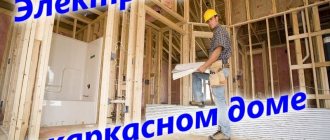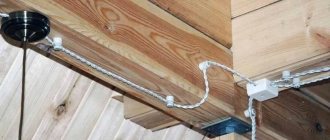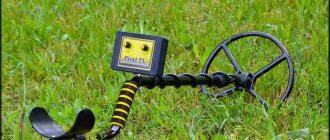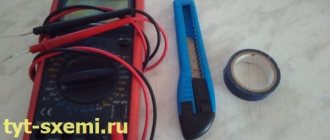Advantages of hidden wiring
When installing electrical wiring, many people choose a hidden installation option that does not spoil the interior design of the room.
The advantages of the method are obvious:
- There are no cable channels on the walls that are conspicuous and interfere with wallpapering the surface.
- Low risk of fire if the rules of the Electrical Installation Regulations are strictly followed during the hidden installation process.
- Ease of cable replacement if it is laid in a corrugated pipe.
- Low risk of mechanical damage due to installation of the product in concrete, metal products or a plaster layer.
- Safety for the residents of the house, because the wires are hidden from view and access to them is limited.
- There are no difficulties when performing finishing work, because the cable is located inside the finishing.
- There are no negative environmental impacts.
These reasons are enough to give preference to hidden wiring when arranging an electrical network in a wooden house.
Selection of wiring materials
Selecting the correct cable cross-section, as well as other consumables, is very important to ensure that your electrical network maintains its performance characteristics for a long time. For example, some builders tend to choose a cable with the largest possible cross-section, believing that in this way they can avoid mistakes. However, this is not entirely the right decision. The cable must exactly match the intended load. In order to avoid complex calculations, you can use one of the tables of recommended power.
It is better to choose copper wire for external electrical wiring in a wooden house. Firstly, it can last much longer than aluminum. Secondly, it has better conductivity. Wiring with NYM copper is most often used, as it has an optimal price-quality ratio. Either metal pipes or (most often) PVC corrugations are used as insulating material for wiring. They are made from modern materials and are self-extinguishing. The insulation of the material protects a person from contact with current, and also allows you to place several wires nearby. For complex cases, insulating pipes made of several layers, as well as with an internal metal layer, are used. Such materials should be used if there is a high probability of damage.
What not to do, installation rules according to the PUE
Some “specialists” take on the installation of hidden wiring without sufficient knowledge and, accordingly, without taking into account the requirements of the PUE.
A common mistake that is made during work is installing a wire on a wooden surface and then covering it with wood trim.
The calculation is made on the strength of the wire and its insulation. Such connivance can lead to a fire, because processes occur in wooden recesses that are impossible to predict.
Over the years, cable products are negatively affected by temperature changes, dust, sudden changes in humidity or damage to insulating materials.
Under increased loads, when electrical equipment is turned on in all rooms (heaters, TV, multicooker and other equipment), a large current flows through the wires. As a result, the risk of a short circuit between two adjacent wires increases.
If there is no reflective non-flammable surface near the cable, a wooden building may catch fire even though it is impregnated with a special fire-fighting compound. It is almost impossible to stop the fire.
When choosing a hidden wiring option in a wooden house, you need to take into account the complexity of the process and the importance of meeting the requirements of GOST R (50571.1-2009) and PUE-7.
If you have no experience, it is better not to undertake installation. Invite qualified specialists who know the norms of the mentioned documents and follow the rules. But you don’t need to stay on the sidelines either. Knowledge of the requirements of the PUE and GOST R helps to control the hired electricians.
Project preparation
When creating a project for hidden wiring, attention is paid to the fire safety of a wooden house. This is true even to the detriment of appearance deterioration.
The hidden wiring diagram should have a minimum of turns. In this case, contact with wood must be avoided. The cable must be laid in copper and steel pipes. In a PVC corrugation or metal hose, installation under asbestos or plaster is allowed, but according to PEU 7 this is prohibited.
Before starting work, it is necessary to develop a project and coordinate it with the local power supply company (District Electric Networks).
PTS service employees develop technical conditions that apply when performing work. First, the total power of electrical appliances is calculated, and then a wiring diagram is developed.
Algorithm of actions when creating a project:
- Development of a technical plan for a wooden house. The diagram indicates the locations of electrical sockets, lamps, switches and electrical appliances with a separate supply.
- The type of cable is selected for each electrical point. If switches with two buttons and “triple” sockets (with a ground tap) are used, a cable with three cores is connected to them.
- The hidden wiring diagram for a wooden house shows the locations for installing junction boxes. To reduce their number, one distribution box is used for two rooms.
- The power consumption of each receiver is indicated. If the device is equipped with an electric motor, the parameter is indicated taking into account the starting current of the motor.
- Light bulbs, sconces and other lighting equipment are brought into one group, and consumers of higher power into the second. For reliability, both branches are connected to their own circuit breaker with an individual rated current.
- The distance from the installation site of hidden wiring to window and door frames, as well as electrical points to the ceiling or floor is indicated. This information is useful and helps protect the wiring from damage during repairs. Electrical cable turns are carried out only at right angles.
After preparing the circuit, the power consumed by electrical appliances is calculated if they are switched on simultaneously.
The rated load current of the input circuit breaker (the one located at the entrance to the room) is also calculated here.
No. 5. Laying cables to the house
There are two ways to route the power cable into the house:
- underground;
- air.
Underground installation is a more reliable and modern technology, but also more difficult to implement. It is justified to use it when building a new house. Under the ground, the cable experiences much less stress than the one hanging in the air and lasts longer: it will not break from the wind or a tree falling on it. Plus, a house without wires hanging around it looks much better. Installation is complex, time-consuming and expensive. You will need to dig a trench at least 80 cm deep; entry into the house is carried out by installing metal sleeves from thick-walled pipes. Power copper wire is used.
Overhead installation will cost less and will be completed faster, but be prepared to be left without electricity in the event of severe bad weather. Carrying out such work is possible if the distance to the object is no more than 25 m - otherwise you will have to install additional support, which costs money. For connection, a self-supporting insulated wire with a cross-linked polyethylene sheath is used; the cross-section and number of cores depends on the connection power.
Aluminum wiring is not installed inside the house - only copper is used, so a VVGng cable is used from the connection point to the input distribution board. For connection, sealed clamps are used, and the VVGng cable, according to the rules, must be enclosed in a metal sleeve made of a thick-walled pipe. In the same sleeve, the cable is led to the distribution panel, if the latter is not placed outside or is not located at the entrance to the house.
The shield is installed in a safe place, ensuring easy access to it. Circuit breakers and RCDs are installed in the switchboard.
Main and input cables, circuit breaker
When choosing a cable for hidden wiring in a wooden house, you need to take into account that it comes in two types - general (runs through the building) and input (to the machine). Let's look at the features for each option.
Basic wiring
The common cable is selected taking into account the loads in the room. When choosing, you need to know the maximum power (current) of the electrical equipment.
So, when using cable products with copper conductors for a cross section of 1.5 mm. sq. rated current is 19 A (for voltage 220 V and 4.1 kV). With a cross section of 2.5 sq. mm. copper wiring can withstand 27 A (5.9 kW).
In rare cases, it may be necessary to install a 4-square wire. In this case, the rated current is 38 A and the power is 8.3 kW. When choosing a cross-section, the rated power of each electrical appliance is taken into account.
The most popular type of cable for hidden wiring is NYM (its features are described above). The advantages are density, ease of installation and the presence of additional insulation, which is important for wooden houses.
The downside is the fear of strong bends, which can lead to damage. When connecting to sockets, cable products with three cores are used, which protects against electric shock. Grounding is also necessary when using powerful floodlights on site.
Project
Do-it-yourself electrical wiring in a wooden house begins with drawing up a project.
Essentially, this should be a house plan that indicates all lighting elements, installation locations for sockets and switches, as well as household electrical appliances that require an individual line (air conditioner, hob, oven, water heater).
It is advisable to indicate the maximum power of electrical appliances on the drawing.
The lighting load is connected by a separate line to an individual circuit breaker (if the house is very large, there may be several of them - for each room or for each floor). It is necessary to provide a separate machine for yard lighting.
click to enlarge
Also, sockets in different rooms are powered by individual lines. If the house is small and there are few rooms, all sockets can be connected from one machine. The exception is the kitchen, which has so many powerful household appliances that a separate line is required.
Thus, you divide the entire household electrical network of your home into groups, now calculate the maximum load for each of them. To do this, the power of all electrical appliances that can be turned on at the same time is summed up. Based on the obtained figures, the power of the input and output machines is selected.
Installation of hidden wiring in a wooden house
Installation of hidden wiring can begin after purchasing the equipment. For the work you will need cable products, AV, switches, sockets and light bulbs (chandeliers).
Distribution boxes are also purchased, which are installed in strict accordance with the specified diagram. When using finishing material, the wires are laid in an armored sleeve.
Subtleties and rules of installation
Unlike external wiring, where it is routed using ceramic rollers or brackets, in the hidden version the cable is hidden in the walls, cable duct or baseboard.
Installation is carried out carefully, because any damage to the insulation is fraught with a short circuit and possible fire. When an arc occurs, the surrounding air heats up to a temperature of 5000 degrees Celsius (this is enough to ignite wood).
The use of plastic corrugations or pipes for installation is unacceptable, because the products do not withstand long-term use and burn out when exposed to high temperatures.
Special wood impregnation does not protect against fire. By the way, steel corrugation does not protect from 5000 degrees, because its walls are small in thickness and are not designed for such heating.
That is why, when installing concealed installations, you need to select equipment that can withstand the high temperatures that occur during a short circuit. If the arc encounters an obstacle on its way, it quickly fades.
A better solution is to make hidden wiring in a wooden house using steel (copper) pipes or ducts. Their peculiarity is the convenience of cutting pieces and the ability to combine using different adapters, soldering or welding equipment.
To increase resistance to rust, the surface of the pipes must be coated with special paint.
You can use copper pipes, which are corrosion-resistant and easy to bend, but they come at a high price.
Rules for installing hidden wiring in a wooden house:
- The cable cannot touch the wooden surface. It is necessary to ensure that every centimeter of wiring is in special protection (a metal pipe or box).
- To install the tube into the wall, you need to make a groove, holes for fastening, or cut out a recess for wiring. To carry out such work will require skill and perseverance.
- Vertical channels are drilled when installing the crowns of the log house. Horizontal laying is done after the walls are installed.
- To pull the cable, a conductor (thin wire) is laid inside the pipe.
- Places of installation and transitions between rooms are insulated using additional elements (asbestos, alabaster, sleeves, metal boxes, etc.)
- When attaching hidden wiring, you need to take into account the number of lines. If several cables pass in one armored sleeve, this requires greater thickness. Hiding such a product in a wooden house is a difficult task.
When creating hidden wiring, you need to remember the importance of the RCD. The device provides instant shutdown when leakage currents occur. For reliability, there must be several devices (for each group).
Selecting a wiring route
When choosing a place to lay a route in a wooden house, you need to take into account the requirements of the PUE. Think through everything in such a way that the number of turns and bends is minimal.
If difficulties arise with pulling the cable due to the characteristics of the building or communications in the walls, junction boxes made of steel or copper are installed at problem points.
PUE and SP: standards and rules for installing electrical wiring in wooden and frame houses
So, let us repeat once again that we have left outside the scope of this article the external installation of electrical wiring in cable ducts. We also do not consider the so-called retro wiring. This option, both in terms of design and financial component, is not suitable for everyone.
Therefore, we set the task - it is necessary to install hidden electrical wiring in a wooden or frame house in a safe and regulated way. Where to begin?
At first glance, it seems that everything is simple - you need to open the PUE (seventh edition dated 07/08/2002) and read paragraph 7.1.38, which says:
Electrical networks laid behind non-passable suspended ceilings and in partitions are considered as hidden electrical wiring, and they should be carried out: behind ceilings and in the voids of partitions made of flammable materials in metal pipes with localization ability and in closed boxes; behind ceilings and in partitions made of non-combustible materials - pipes and ducts made of non-flammable materials, as well as flame retardant cables. In this case, it must be possible to replace wires and cables.
Now we open the document for frame builders, namely SP 31-105-2002 “Design and construction of energy-efficient single-apartment residential buildings with a wooden frame.” Read paragraph 13.5.1:
Electrical wiring should be installed by passing cables (wires in a protective sheath) through voids or spaces filled with insulation inside the walls and ceilings of the house, as well as through holes in the wooden frame elements of walls and ceilings. The passage of such cables and wires through the structure of the house can be arranged without the use of bushings and tubes.
And paragraph 13.5.2:
For electrical wiring, insulated wires in protective sheaths or cables in sheaths made of flame retardant materials should be used.
A cable is two or more insulated conductors connected together and covered with insulation.
A wire is a single-core or multi-core conductor with or without insulation.
Accordingly: due to discrepancies in the PUE with the joint venture and the vagueness of the wording in the PUE, many users have a question - how to properly install electrical wiring on flammable materials. As prescribed in the PUE - by laying it in a steel pipe. Or as it is written in the joint venture - using a flame retardant cable without additional protective sheaths.
Workers can, while installing drywall or drilling something, pierce an unprotected cable with a screw or nail. The cable insulation can be damaged by the sharp edge of the metal profile. The cable can be chewed (optionally) by rats or mice. In addition, the accumulation of wood dust during a spark or breakdown of insulation can lead to the rapid spread of flames inside the walls.
Of course, at first glance it seems that such a solution is redundant, but in this way we protect the cable from force majeure circumstances, including the common situation: “I forgot where the cable goes in the wall, hung a shelf/picture and damaged it.”
Although, in order to avoid such situations, we do not lay the cable as it is necessary, but along strictly defined and marked cable routes, if necessary, taking photographs with an attached tape measure.
Electrical wiring test
After installing hidden wiring, it must be tested. This is especially important for wooden houses with a low level of fire resistance.
When checking, special instruments are used, and trained employees of electrical laboratories are invited to perform the work.
The range of events includes:
- visual inspection;
- grounding resistance measurement;
- AB check;
- phase-zero circuit test;
- checking protective devices;
- control of the chain between the ground electrode and the devices.
After completion of the work, a test report is drawn up and submitted. Carrying out such measures is mandatory, because they help to avoid accidents and prevent equipment breakdowns.
Useful tips
In conclusion, we present tips and results regarding the implementation of hidden wiring in wooden houses.
Basic points:
- For electrical wiring in a wooden house, it is better to use NYM - a cable with triple electrical insulation.
- The best circuit protection is provided by differential circuit breakers that protect the network from short circuits and leakage (RCD).
- Grounding junction boxes and metal pipes is a mandatory safety element.
- During installation, you need to take into account the shrinkage of the wooden house to avoid distortion and damage to the wires.
- The pipe connection must be as reliable as possible. Welding and soldering are used for joining.
- The best pipes are copper. Their advantages are resistance to corrosion and ease of bending.
- Plastic inserts are used at the ends of the pipes to protect the cable from damage.
- If lining or wooden wallpaper is used during installation, you can run pipes along the existing recesses.
- In a wooden house it is allowed to combine hidden and open wiring.
- Installation is done exclusively according to a scheme agreed upon with experts.
- The main attention is paid to fire protection, and only after that the aesthetic component.
- The optimal solution is to lay channels in existing recesses, window and door openings, under baseboards or ceiling cladding.
- When using corrugated pipes, it is necessary to cover the surface with plaster or asbestos gaskets.
- The pipes are joined together by threading or welding.
- Distribution boxes must be freely accessible.
Comments:
Zahar
It’s better to get confused like this than to do retro wiring with porcelain “bumps”.
Stepanych
Why use copper pipes? Isn't it too expensive?
Stas
Stepanych, copper pipes bend easily and are very light, because... They have thin walls, so it is very convenient to lay wires in them. Moreover, such a pipe can first be laid empty inside a wooden structure and only then the cable can be pulled through it.
Leave a comment Cancel reply
Similar posts
Features and some secrets of installing open wiring in a wooden house with your own hands Drawing up a wiring diagram for a one-room apartment, selecting the necessary equipment
Features and scope of use of multi-core flexible copper cable
Types and areas of application of metal cable channels











